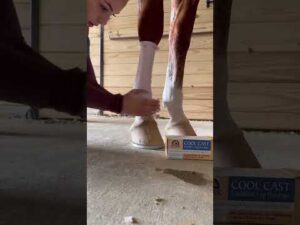A bowed tendon refers to an injury of the superficial or deep digital flexor tendons in a horse’s leg. It is common in performance horses and can range from mild inflammation to severe fiber tears. Proper care is crucial for recovery and long-term soundness.
Symptoms of a Bowed Tendon:
✅ Swelling and thickening along the back of the leg
✅ Heat and tenderness in the tendon area
✅ Lameness (varies depending on severity)
✅ A noticeable “bowed” appearance in severe cases
Treatment & Recovery Plan:
1. Immediate Care (First 48–72 Hours)
✔ Cold Therapy – Apply ice packs or cold hose the leg 2–3 times daily for 15-20 minutes.
✔ Anti-Inflammatories – Administer NSAIDs (e.g., Bute, Banamine) as prescribed by your vet.
✔ Rest & Stall Confinement – Prevent further strain by restricting movement.
✔ Compression Bandaging – Wrap the leg with a support bandage to control swelling.
2. Veterinary Assessment
🔎 Ultrasound – A vet will assess tendon fiber damage and determine treatment.
🩺 Medications – In severe cases, vets may recommend corticosteroid injections or regenerative therapies (e.g., PRP, stem cell therapy).
3. Long-Term Healing & Rehabilitation (Weeks to Months)
🏇 Strict Stall Rest (4–6 Weeks) – No turnout or forced exercise.
🚶 Controlled Hand-Walking (After Vet Approval) – Gradually increase exercise over 3–6 months.
🔬 Shockwave Therapy or Laser Therapy – May be recommended to promote healing.
💊 Tendon Supplements – Consider collagen, MSM, or Omega-3s to aid recovery.
4. Returning to Work (After 6+ Months)
🐎 Slowly Introduce Trotting & Cantering under vet guidance.
🛑 Monitor for Swelling or Heat after exercise.
🔄 Ongoing Maintenance – Regular checks, proper shoeing, and conditioning are essential.
Preventing Bowed Tendons:
✅ Proper Warm-up & Cool-down before and after workouts.
✅ Good Footing – Avoid deep, uneven, or excessively hard surfaces.
✅ Correct Shoeing & Trimming to support proper movement.
✅ Conditioning – Avoid overexertion and sudden increases in workload.
Recovery Time:
🕒 Mild Cases: 3–6 months
🕒 Severe Cases: 9–12 months or longer
Bowed tendons require patience and diligent care. If managed properly, many horses can return to full activity.
